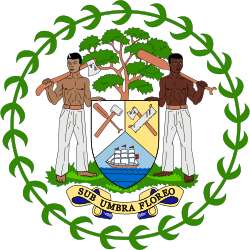 |
|---|
Belize is divided into six districts: Belize, Cayo, Corozal, Orange Walk, Stann Creek and Toledo.
 |
|---|
Belize is divided into six districts: Belize, Cayo, Corozal, Orange Walk, Stann Creek and Toledo.

| District | Capital | Area [1] | Population (2019) [2] | Population (2010) [1] | Change | Population density (2019) |
|---|---|---|---|---|---|---|
| Belize | Belize City | 4,310 km2 (1,663 sq mi) | 124,096 | 95,292 | +30.2% | 28.8/km2 (74.6/sq mi) |
| Cayo | San Ignacio | 5,200 km2 (2,006 sq mi) | 99,118 | 75,046 | +32.1% | 19.1/km2 (49.4/sq mi) |
| Corozal | Corozal Town | 1,860 km2 (718 sq mi) | 45,310 | 41,061 | +10.3% | 24.4/km2 (63.1/sq mi) |
| Orange Walk | Orange Walk Town | 4,600 km2 (1,790 sq mi) | 52,550 | 45,946 | +14.4% | 11.3/km2 (29.4/sq mi) |
| Stann Creek | Dangriga | 2,550 km2 (986 sq mi) | 48,162 | 34,324 | +40.3% | 18.9/km2 (48.8/sq mi) |
| Toledo | Punta Gorda | 4,410 km2 (1,704 sq mi) | 37,124 | 30,783 | +20.6% | 8.4/km2 (21.8/sq mi) |
| Ethnicity | Corozal | Orange Walk | Belize | Cayo | Stann Creek | Toledo | 2010 | 2000 |
|---|---|---|---|---|---|---|---|---|
| Total | 39,539 | 44,804 | 87,523 | 70,157 | 31,514 | 29,885 | 303,422 | 232,111 |
| Asian | 266 | 344 | 1,220 | 648 | 265 | 80 | 2,823 | 1,716 |
| Black/African | 65 | 41 | 729 | 199 | 79 | 38 | 1,151 | 582 |
| Caucasian/White | 341 | 98 | 1,156 | 787 | 476 | 241 | 3,099 | 1,758 |
| Creole | 2,151 | 2,402 | 42,107 | 10,247 | 5,128 | 1,022 | 63,057 | 57,859 |
| East Indian | 1,142 | 159 | 2,041 | 806 | 917 | 1,421 | 6,486 | 6,868 |
| Garifuna | 235 | 262 | 3,578 | 975 | 7,518 | 1,417 | 13,985 | 14,061 |
| Hindu | 106 | 76 | 320 | 50 | 28 | 7 | 587 | n.a |
| Lebanese | 52 | 0 | 146 | 39 | 3 | 0 | 240 | n.a |
| Maya ‐ Ketchi | 68 | 72 | 837 | 1,408 | 1,333 | 13,691 | 17,409 | 12,366 |
| Maya ‐ Mopan | 84 | 237 | 627 | 1,936 | 3,166 | 4,507 | 10,557 | 8,980 |
| Maya ‐ Yucatec | 289 | 164 | 166 | 1,469 | 29 | 24 | 2,141 | 3,155 |
| Mennonite | 2,566 | 4,852 | 353 | 2,809 | 46 | 239 | 10,865 | 8,276 |
| Mestizo/Spanish/Latino | 30,061 | 34,616 | 26,974 | 44,445 | 9,501 | 5,324 | 150,921 | 113,045 |
| Other | 30 | 40 | 356 | 164 | 132 | 40 | 762 | 2,610 |
| Mixed ethnicity | 1,893 | 1,355 | 6,835 | 4,145 | 2,885 | 1,834 | 18,947 | n.a. |
| Don't know/not stated | 190 | 86 | 78 | 30 | 8 | 0 | 392 | 835 |